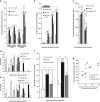A high-salt diet enhances leukocyte adhesion in association with kidney injury in young Dahl salt-sensitive rats
- PMID: 28298656
- PMCID: PMC5675900
- DOI: 10.1038/hr.2017.31
A high-salt diet enhances leukocyte adhesion in association with kidney injury in young Dahl salt-sensitive rats
Erratum in
-
Erratum: A high-salt diet enhances leukocyte adhesion in association with kidney injury in young Dahl salt-sensitive rats.Hypertens Res. 2017 Nov;40(11):945. doi: 10.1038/hr.2017.71. Hypertens Res. 2017. PMID: 29105660 Free PMC article.
Abstract
Salt-sensitive hypertension is associated with severe organ damage. Generating oxygen radicals is an integral component of salt-induced kidney damage, and activated leukocytes are important in oxygen radical biosynthesis. We hypothesized that a high-salt diet causes the upregulation of immune-related mechanisms, thereby contributing to the susceptibility of Dahl salt-sensitive rats to hypertensive kidney damage. For verifying the hypothesis, we investigated leukocytes adhering to retinal vessels when Dahl salt-sensitive rats were challenged with a high-salt (8% NaCl) diet using acridine orange fluoroscopy and a scanning laser ophthalmoscope. The high-salt diet increased leukocyte adhesion after 3 days and was associated with a significant increase in mRNA biosynthesis of monocyte chemotactic protein-1 and intercellular adhesion molecule-1 (ICAM-1) -related molecules in the kidney. Losartan treatment did not affect increased leukocyte adhesion during the early, pre-hypertensive phase of high salt loading; however, losartan attenuated the adhesion of leukocytes during the hypertensive stage. Moreover, the inhibition of leukocyte adhesion in the pre-hypertensive stage by anti-CD18 antibodies decreased tethering of leukocytes and was associated with the attenuation of functional and morphological kidney damage without affecting blood pressure elevation. In conclusion, a high-salt challenge rapidly increased leukocyte adhesion through the over-expression of ICAM-1. Increased leukocyte adhesion in the pre-hypertensive stage is responsible for subsequent kidney damage in Dahl salt-sensitive rats. Immune system involvement may be a key component that initiates kidney damage in a genetic model of salt-induced hypertension.
Conflict of interest statement
HT recieved grants from JSPS KAKENHI, Bayer Yakuhin, Nihon Alcon, and Novartis Pharmaceuticals, outside this work. YY is a Board member of Bayer Yakuhin, Novartis Pharmaceuticals and Santen Pharmaceutical, outside this work.
Figures



References
-
- Olefsky JM, Glass CK. Macrophages, inflammation, and insulin resistance. Annu Rev Physiol 2010; 72: 219–246. - PubMed
-
- Liu HQ, Wei XB, Sun R, Cai YW, Lou HY, Wang JW, Chen AF, Zhang XM. Angiotensin II stimulates intercellular adhesion molecule-1 via an AT1 receptor/nuclear factor-kappaB pathway in brain microvascular endothelial cells. Life Sci 2006; 78: 1293–1298. - PubMed
-
- Arndt H, Smith CW, Granger DN. Leukocyte-endothelial cell adhesion in spontaneously hypertensive and normotensive rats. Hypertension 1993; 21: 667–673. - PubMed
-
- Shen K, Sung KL, Whittemore DE, DeLano FA, Zweifach BW, Schmid-Schonbein GW. Properties of circulating leukocytes in spontaneously hypertensive rats. Biochem Cell Biol 1995; 73: 491–500. - PubMed
MeSH terms
Substances
LinkOut - more resources
Full Text Sources
Other Literature Sources
Medical
Molecular Biology Databases
Research Materials
Miscellaneous

